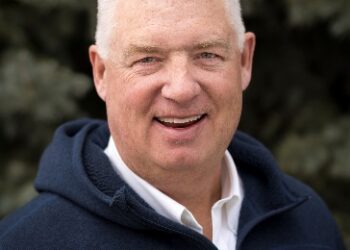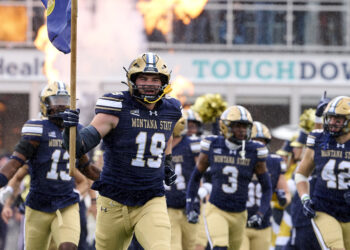BILLINGS (AP) – During lunch at Crow Agency Elementary School, students hunch over the table, eating oranges.
They know the Crow word for yellow – shíile – and for red – hísshe. But the second-graders struggle with other colors, like orange, reported the Billings Gazette.
“It’s hard to say,” Zarah Nomee said.
“No, purple’s hard to say,” Kyler Haugen chimed in.
What about blue, like their milk cartons?
“That’s hard to say, too,” Haugen said.
What about animal names?
“Iichíile!”
‘Background knowledge’
Teachers at the small elementary school on the Crow Reservation have informally incorporated Apsaalooke into their lessons for years. But this is the first year the school is coordinating a cohesive approach, anchored by a kindergarten immersion class.
“I started off with their background knowledge,” said kindergarten teacher Lavonna Real Bird. “That’s very important.”
Students chimed together, “iichíile,” when shown a sheet of paper with pictures of horses.
“They know what a horse is, they see a horse all the time,” Real Bird said. “Even babies say iichíile.”
From there, they count out how many horses are on the paper – hawáte, dúupe, dáawiia, shoopé, chiaxxó, up to five.
School principal Jason Cummins is trying to shift how the school thinks about language, especially for students who don’t come from Crow-speaking homes.
“We don’t just want to blame anybody anymore,” he said. “I think that’s been a crutch . We don’t say, `If only your family taught you quadratic equations.”’
The language learning level in Real Bird’s classroom mirrors kindergarten content. Students sing songs for numbers, months, and days of the week in both English and Crow, swaying just-counted fingers. Math lessons are taught first in Crow, then repeated in English. Reading instruction occurs in English, but everything else is in Crow.
As students practice numbers in Crow, they also work on addition problems. They go over body parts on a diagram with things labeled in Crow.
“Some people think, just talk to them,” Cummins said. “(But) language acquisition is different from language instruction. We don’t just wing it. We need to treat it like any other content area.”
Politics
That’s an approach echoed by Jioanna Carjuzaa, a professor at Montana State University.
“True immersion means that you’re using language as a vehicle to focus on other content,” she said.
Carjuzaa visited the school earlier in October with a group of teaching students from countries around the world.
Native language teachers, like other teachers, need training, she said.
“They need professional development,” she said. “There’s no question that the elders and the tribal members have the knowledge and the wisdom. (But) they’re not an integrated part of the teaching staff.”
Some language advocates argue for a more informal approach; during a conference earlier this year in Billings, a co-founder of a language immersion school in Minnesota highlighted the school’s reliance on tribal members without formal teacher training.
And the continued development of language itself can be “very political,” Carjuzza said.
That’s something Cummins works to steer clear of.
“I don’t care who gets the credit, I just want my kids to learn,” he said.
Funding
Language immersion preschools received a political boost with the passage legislation from Sen. Jonathan Windy Boy, who represents the Rocky Boy Reservation, opening state funding for teaching Native languages with dwindling speakers. Montana’s Indian Education for All provision, which requires the teaching of Native American culture and history in public schools and is backed up by dedicated funding, has been held up as a model of curriculum integration. But language instruction has lagged.
“It’s really in a lot of ways in the very infantile stages,” Carjuzaa said. “There’s a real push to embrace immersion programs.”
Some private schools have emphasized the topic for several years.
The Nkwusm Salish Language School was established in 2002 on the Flathead Reservation and offers a “a complete academic experience dedicated to the promotion and preservation of the Salish Language.”
The Piegan Institute’s Cuts Wood Academy in Browning was founded in 1995 with the mission of creating more Blackfeet language speakers while providing a K-8 education.
And on the Crow and Northern Cheyenne reservations, St. Labre and its satellite schools have incorporated American Indian language for several years.
In public schools, “it’s very sporadic,” Carjuzaa said. “It depends on who the teachers are and what the commitment is.”
In addition to Crow Agency, public schools in Browning and Wyola have used the new funding to create language programs.
School and home
Real Bird grew up in a Crow-speaking home.
“When I talk to another Crow-speaking adult, it’s so natural, it’s normal,” she said. “The challenge is trying to speak to a young child in Crow.”
It’s become a widespread condition: educators said that adults often will speak English to children despite being fluent in Crow, as more children understand English and there’s no need to adapt their Crow to a lower comprehension level.
Crow Agency Elementary has a preschool class that heavily incorporates Crow language, though it’s not a true immersion program. It can give kids a jump start on Crow, just like other subjects, whether they come from a Crow-speaking home or not.
“When they go to Head Start or preschool, when they come they have an idea. Same thing with Crow,” Real Bird said.
But it’s an inescapable fact that students who hear Crow at home will have a leg up.
“Just like anything we do in the classroom, if it’s reinforced at home, they’re going to improve,” Real Bird said.
In the classroom, there’s a dearth of resources for teaching Crow. Real Bird makes most of her own teaching materials and plans her own lessons.
Cummins is working with other language groups to provide assessment options in Crow for students; English proficiency has been shown to have a significant effect on standardized test scores, and scholars have debated if tests carry an inherent cultural bias.
“We’ve had some kids that we thought were having challenges behaviorally,” he said. It turned out that it was a language issue.
“I’m not saying that’s an answer to everything,” Cummins said. He doesn’t expect language instruction to single-handedly bridge American Indian academic achievement gaps that are well documented in reservation schools and schools in predominantly white areas.
But language isn’t just an academic issue. It’s a matter of identity.
“Different people have different opinions,” Real Bird said. “I believe that Crow means speaking our Crow language.”
Copyright 2016 Associated Press. All rights reserved. This material may not be published, broadcast, rewritten, or redistributed












